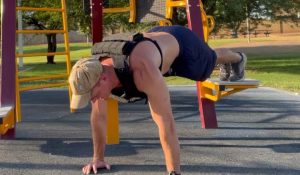Whether you’ve spent the last few months getting ready for your first Murph, or you have a goal of crushing last year’s time with a new PR, it’s essential to have a Murph workout strategy in place for the day of the event itself!
In this article, we’ll take a deeper dive into how to determine the best Murph strategy for you, as well as some “day of” tips for Murph.
Ready? Let’s go:
A quick primer
Let’s get this out of the way – this article will focus on Murph strategy and Murph workout tips, aka how to eke out every bit of performance on the day of the Murph Challenge in order to hit that new PR.
We will not be covering any training plans in this article (though your performance during any Murph-specific training plan should directly inform your strategy decisions for the Murph workout itself).
If you’re looking for a full run down of how to train for Murph, check out our full article on Murph training plans.
With that said, we can categorize our strategy for Murph into two buckets of factors:
- Strategic decisions to sort out before the day of the Murph Challenge (in the weeks or days prior)
- Tips and strategy for optimizing your performance on the actual day of the event itself
Let’s tackle these one-by-one:
Before the day of the Murph Challenge
Tip 1: Decide which variant of Murph you’ll be doing

While most of us think “Rx” for the actual Murph Challenge, there are likely many more people out there who will be doing a close variation of the Murph Challenge. There’s nothing wrong with that!
Whether you’re planning to ditch the weight vest and perform the workout “slick”, or you’re planning to sub out pull-ups for another exercise, it would behoove you to decide at least a few weeks in advance about whether you’ll be doing Murph “proper”, or choosing a variation of Murph.
Do you have a certain exercise that is a weak point for you? If so, you may want to choose a Murph variation that works around that weakness.
Do you have an equipment or space limitation? Perhaps you’ll want to jump rope or use a treadmill instead of going out on a run. Maybe you want to use some type of inverted row if you don’t currently have access to a pull-up bar.
Are you concerned that you won’t be able to finish the full event? Perhaps you want to plan on scaling the Murph Challenge instead of going full-hog on your first go.
Regardless, it’s important to have thought these things through in advance, so you know what you’re training for.
Tip 2: Decide how you’ll break up the reps
There are numerous popular and (some not-so-popular) partitioning schemes commonly used in the Murph Challenge. The most well-known, of course, is 20 rounds of “Cindy” (5 pull-ups, 10 push-ups, 15 weighted vest squats).
However, perhaps you’ve noticed in your training that you tend to gas out after 8-10 rounds of Cindy during your weighted vest strength sessions. Maybe you’ll want to choose a lower rep scheme, such as:
- 25 rounds of 4 pull-ups, 8 push-ups, 12 air squats
- 33 rounds of 3 pull-ups, 6 push-ups, 9 air squats (followed by a single round of 1, 2, 3)
Or maybe you’ve realized that one particular exercise holds you back more than the others. Maybe you want to try an atypical partitioning scheme. A few examples:
- If you struggle with pull-ups: 3 pull-ups, 10 push-ups, 2 pull-ups, 15 squats x20
- If you struggle with push-ups: 5 push-ups, 5 pull-ups, 5 push-ups, 15 squats x20
Or, perhaps you are a total beast and want to try to complete the challenge in 10 rounds (or less):
- 10 pull-ups, 20 push-ups, 30 squats x10, or
- 10 push-ups, 10 pull-ups, 10 push-ups, 30 squats x10
Regardless, you want to have a solid idea of a partitioning plan that you can accomplish without being completely crushed half-way through the workout.
Tip 3: Figure out how fast your first mile needs to be

Though this can be a range (say, 7:30-8:00), you should have a very good idea of how fast you need to run your first mile.
How do you figure this out? At some point leading up to the event (preferably at least 2-3 weeks prior), you’ll want to test your one-mile time with your weight vest or body armor (if you’re planning to use one). Remember that running in a weight vest is a different stimulus than regular running – I suggest using the weight vest for your “test” run if you’re planning to use one on Memorial Day.
Once you know, generally, how fast you can run a mile with your weight vest of choice, add 20-25% to that time, and use that as your planned first mile pace.
As an example:
- If you ran your one mile test in 7:00, then use 8:30-9:00 for your first mile
- If you ran your one-mile test in 6:00, then use 7:30-8:00 for your first mile
- … and so on
Note that this tip is not to keep you on pace, it’s to save you from yourself.
One of the most common blunders in the Murph Challenge is to take off like a rocket on your first mile, and then gas out halfway through the workout. This leads to the second half of Murph being a miserable (and slow) slog with long rest periods – no bueno!
Get your first mile time figured out a few weeks in advance, and stick to it!
Tip 4: Pre-decide which on-the-fly modifications you will make when you start to “gas out”
If you’re going for a PR time, it’s important to consider on-the-fly modifications you will make when you start to fatigue. This is one of the most underrated tips for Murph.
Remember, Murph is about continually moving until the workout is finished. Reaching muscular failure is a real killer in the Murph Challenge.
As you fatigue, you’ll either need to take longer rest periods, or modify your rounds so that you can keep moving.
Take, for example, someone who is planning to do the classic “20 rounds of Cindy”:
If their pushing muscles fatigue, they could switch to 5 push-ups, 5 pull-ups, 5 push-ups, 15 squats. This would allow the person to continue without having to lengthen their rest periods.
Alternatively, if your “pulling” muscles fatigue faster, then just take the opposite approach by doing 3 pull-ups, 10 push-ups, 2 pull-ups, 15 squats.
What about when the end of the workout looms near, but both our pushing and pulling muscles are fatigued? Then you’d switch to: 3 pull-ups, 5 push-ups, 2 pull-ups, 5 push-ups, 15 squats.
You get the idea. You can, of course, adapt this line of thinking to the set and rep scheme that you’ve chosen.
The point here is that you don’t want to be trying to do math in your head when you’re 2/3rds of the way through Murph. This will cause you to lose time, and dedicate valuable mental energy to something other than simply completing the workout.
Tip 5: Get adequate nutrition, hydration, and sleep the night before the event
If you’ve participated in endurance events in the past, you’ll likely be familiar with a process that works for you to address nutrition, hydration, sleep, etc. If you’re not, here’s a quick run-down to optimize performance:
- Nutrition: Get adequate carbohydrates, just like you would if you were heading into a half-marathon in the morning.
- Hydration: Drink plenty of water the day before the event, preferably stopping about two hours before bed. This will allow you to be hydrated through the night without having to get up during the night to go to the bathroom, cutting into valuable rest time.
- Sleep: Get 8-9 hours of sleep the night before.
Of course, you can modify this “night before” plan to suit your needs.
On the day of the Murph Challenge
Assuming you’ve developed your strategy ahead of time, the following Murph workout tips will help you crush that PR on the day of the Challenge itself:
Tip 6: Warm up properly
While many folks would consider this a no-brainer, but making sure you’re properly warmed up prior to the beep is going to do nothing but help.
What I won’t do is make specific recommendations as to what your warm-up should be. Ideally, you already know what it takes to get your muscles warm and your joints moving. So, I would advise you to do whatever you would normally do to warm-up.
If you’re a fan of dynamic or static stretching prior to a workout? Great, do it. Maybe you’re someone who normally runs an easy 400m jog to loosen up your hips. Go ahead.
In training, I often use the first mile as the warm-up. For most training sessions, I find that an easy 1-mile run is a perfect warm-up. However, on the day of the Challenge itself, you want to be fresh and warm when the workout starts. If you’re going for a PR, you don’t want to be warming up during your first mile.
Tip 7: Hydrate properly, and get the right type of nutrition
Assuming you’ve eaten properly the night before, you shouldn’t be waking up excessively hungry. Eating a few calories beforehand might not be a bad idea, but resist the urge to eat a full meal prior to the Murph Challenge. Something simple like a piece of fruit should do the trick.
Next is hydration. A simple trick that endurance athletes use to get properly hydrated prior to an event is to drink plenty of water about two hours before you plan to begin your event. When done properly, you should need to use the bathroom once or twice before the event starts.
This leads you to be well hydrated during the event, but you won’t need to use the bathroom during your event. After using the bathroom, gulp a bit more water, and you shouldn’t need to go to the bathroom again for another hour or two – plenty of time to set a nice PR!
Tip 8: Modulate your speed on the first mile

Here’s some conventional wisdom about the Murph Challenge – resist the temptation to tear through the first mile like a bat out of hell.
Murph PRs are set in the second half of the workout, by keeping the pace, and not gassing out halfway through. One of the quickest ways to shoot your performance in the foot is to leave nothing on the table after your first mile run.
Since you should have decided on your first mile pace during your training in the weeks leading up to the event, all you’ve got to do is actually run the pace you planned. A simple running app on your phone can help you with this. If you notice that you’re running too fast, slow down. Your performance (and your body) will thank you 30 minutes from now!
… which leads us right to our final point:
Tip 9: Have a plan in place to keep count of your rounds

As mentioned earlier, you don’t want to be doing math in your head in the middle of the Murph Challenge.
While counting to 20 rounds seems simple now, it’s not so easy when you’re 14-and-a-half rounds deep, making on-the-fly modifications to your set and rep scheme to keep going, and trying to convince yourself to complete your 15th set of pull-ups.
A simple solution to this is to have some type of “counter” available as you go. A deck of cards or a set of poker chips works well for this. Count out 20, 25, or however many cards (or chips) you’ll need and set them in a pile somewhere near where you’ll be doing your squats.
Every time you complete a set of squats, move a chip or card from one pile to the other. Your goal is to simply keep going until you’ve moved all the items from one pile to the other.
Easy peasy.
Tip 10: Keep the pace (don’t gas out!)
The last piece of wisdom to follow is to simply keep the pace.
A deceptively simple recommendation, but if you’ve completed this high volume CrossFit Hero WOD in the past, you’ve likely noticed two trends:
- People tend to go too fast for the first half of the workout
- They tend to go too slow during the second half (usually because of mistake #1 above)
If you’ve planned to do a round of Cindy every two minutes for 40 minutes, then resist the temptation early on to start your next round early. If you’ve baked short rest periods into your plan, then take the rest periods rather than eliminating them and then having to play “catch up” at the end.
30-second rest periods in the beginning are far better than taking 5-minute rest periods at the end because you tried to skirt your own plan.
Good luck, and see you on Memorial Day!
As I always say, it’s important to remember that the point of the Challenge is to test our own fitness while remembering Navy Seal Lt Michael P. Murphy and all those who’ve made the ultimate sacrifice.
Don’t get too lost in the weeds with your CrossFit Murph strategy: remember to have a good time, embrace the suck, and leave it all on the table.
See you on Memorial Day!





















